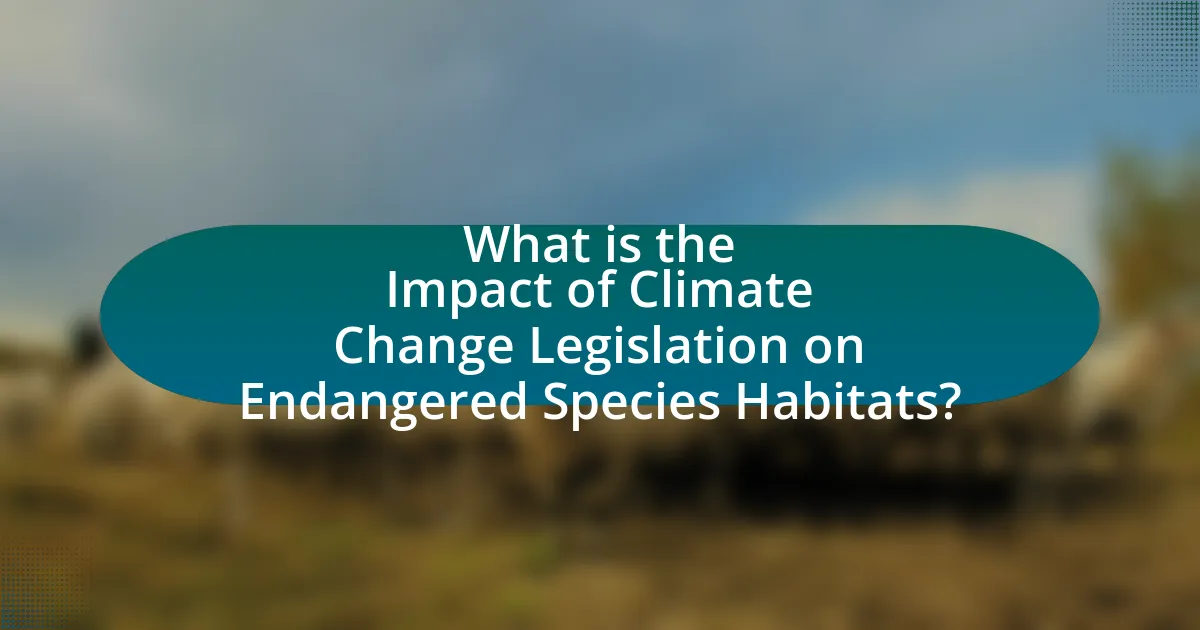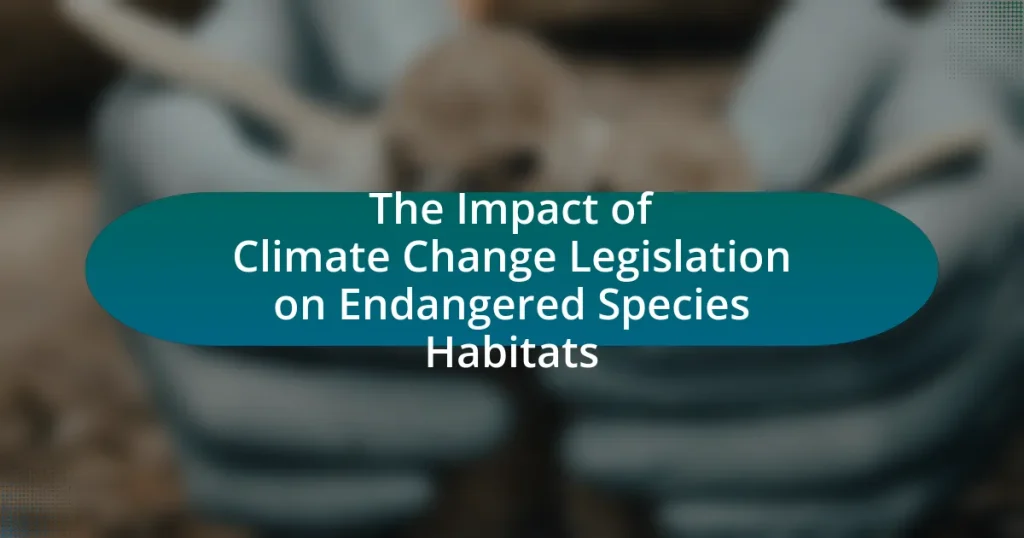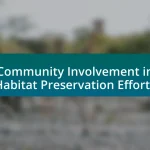The article examines the impact of climate change legislation on endangered species habitats, highlighting how such laws promote conservation efforts and mitigate climate-related threats. It discusses key legislation, including the Endangered Species Act, which designates critical habitats and supports biodiversity. The article also addresses the influence of climate change on species survival, the role of stakeholders in shaping legislation, and the challenges faced in enforcing existing laws. Additionally, it emphasizes the importance of integrating scientific research and community engagement to enhance habitat conservation efforts.

What is the Impact of Climate Change Legislation on Endangered Species Habitats?
Climate change legislation positively impacts endangered species habitats by promoting conservation efforts and reducing greenhouse gas emissions. Such legislation often includes measures to protect critical habitats, restore ecosystems, and mitigate climate-related threats. For instance, the Endangered Species Act in the United States has been instrumental in designating protected areas for species at risk, which helps maintain biodiversity and ecosystem health. Additionally, studies show that effective climate policies can lead to improved habitat conditions, as seen in the restoration of wetlands and forests, which are crucial for many endangered species.
How does climate change legislation influence the conservation of endangered species?
Climate change legislation significantly influences the conservation of endangered species by establishing legal frameworks that protect habitats and promote biodiversity. These laws often include measures to reduce greenhouse gas emissions, which mitigate climate change impacts that threaten species survival. For instance, the Endangered Species Act in the United States has provisions that allow for the designation of critical habitats, which are essential for the recovery of endangered species. Research indicates that effective climate policies can lead to improved habitat conditions, thereby enhancing the resilience of vulnerable species to climate-related threats. Additionally, legislation can facilitate funding for conservation programs aimed at protecting endangered species from the adverse effects of climate change, such as habitat loss and altered ecosystems.
What specific laws are designed to protect endangered species habitats?
The Endangered Species Act (ESA) is the primary law designed to protect endangered species habitats in the United States. Enacted in 1973, the ESA aims to prevent the extinction of imperiled species and to promote the recovery of their populations by protecting their habitats. Under the ESA, critical habitat designations are made to ensure that areas essential for the conservation of listed species are safeguarded from destruction or adverse modification. Additionally, the National Environmental Policy Act (NEPA) requires federal agencies to assess the environmental impacts of their actions on endangered species and their habitats, further reinforcing habitat protection.
How do these laws address the effects of climate change?
These laws address the effects of climate change by implementing regulations that aim to reduce greenhouse gas emissions and promote conservation efforts for endangered species habitats. For example, the Endangered Species Act includes provisions that require federal agencies to consider the impacts of climate change on listed species and their habitats, ensuring that conservation strategies are adapted to changing environmental conditions. Additionally, the Clean Air Act has been utilized to regulate emissions from power plants, which contributes to mitigating climate change and protecting ecosystems that support endangered species. These legislative measures are supported by scientific studies indicating that proactive climate policies can significantly enhance the resilience of vulnerable habitats against climate-related threats.
Why is it important to understand the relationship between climate change and endangered species?
Understanding the relationship between climate change and endangered species is crucial because climate change significantly alters habitats, threatening the survival of vulnerable species. For instance, rising temperatures and changing precipitation patterns can lead to habitat loss, food scarcity, and increased competition among species. According to the Intergovernmental Panel on Climate Change (IPCC), approximately one million species are at risk of extinction due to climate-related factors. This understanding is essential for developing effective conservation strategies and legislation aimed at protecting endangered species and their habitats from the adverse effects of climate change.
What are the primary threats to endangered species from climate change?
The primary threats to endangered species from climate change include habitat loss, altered food availability, and increased disease prevalence. Habitat loss occurs as rising temperatures and changing precipitation patterns lead to the degradation of ecosystems, making them unsuitable for many species. For instance, the Intergovernmental Panel on Climate Change (IPCC) reports that climate change could lead to the loss of up to 30% of species at risk of extinction if global temperatures rise by 2 degrees Celsius. Altered food availability affects species that rely on specific plants or prey, as shifts in climate can disrupt their life cycles and migration patterns. Additionally, increased disease prevalence can occur as warmer temperatures expand the range of pathogens and parasites, threatening the health of vulnerable species. These factors collectively contribute to the decline of endangered species in a changing climate.
How do changes in habitat affect species survival rates?
Changes in habitat significantly affect species survival rates by altering the availability of resources, shelter, and breeding grounds. For instance, habitat destruction due to deforestation can lead to a decline in food sources and nesting sites, which directly impacts species populations. A study published in the journal “Ecology Letters” found that species experiencing habitat loss had a 50% higher risk of extinction compared to those in stable environments. Additionally, climate change-induced habitat shifts can force species to migrate, often leading to increased competition and reduced genetic diversity, further threatening their survival.
What role do stakeholders play in climate change legislation affecting endangered species?
Stakeholders play a crucial role in climate change legislation affecting endangered species by influencing policy development, advocating for specific protections, and ensuring that the needs of both species and human communities are considered. These stakeholders include government agencies, non-governmental organizations, scientists, local communities, and industry representatives, all of whom contribute to the legislative process through public comments, lobbying efforts, and collaborative initiatives. For instance, the Endangered Species Act in the United States has been shaped by stakeholder input, which has led to the incorporation of scientific research and local knowledge in decision-making processes. This collaborative approach helps to balance ecological needs with economic interests, ultimately aiming to create effective legislation that protects endangered species and their habitats in the face of climate change.
Who are the key stakeholders involved in this legislation?
The key stakeholders involved in climate change legislation affecting endangered species habitats include government agencies, environmental organizations, local communities, and industry representatives. Government agencies, such as the Environmental Protection Agency, play a crucial role in enforcing regulations and policies. Environmental organizations advocate for the protection of endangered species and their habitats, often providing scientific research and public awareness. Local communities are directly impacted by legislation and may participate in conservation efforts or face economic changes. Industry representatives, particularly from sectors like agriculture and energy, are involved in discussions regarding compliance and the economic implications of such legislation. These stakeholders collectively influence the development and implementation of climate change policies that aim to protect endangered species habitats.
How do stakeholder interests align or conflict regarding habitat protection?
Stakeholder interests regarding habitat protection often conflict due to differing priorities and values. For instance, environmental organizations advocate for strict habitat protection to preserve biodiversity, while developers may prioritize land use for economic growth, leading to habitat destruction. Additionally, local communities may seek to balance conservation with their needs for resources, creating further tension. Research indicates that these conflicting interests can hinder effective habitat protection efforts, as seen in cases where legislation aimed at protecting endangered species is challenged by economic interests, resulting in legal disputes and policy delays.
How can climate change legislation be improved to better protect endangered species habitats?
Climate change legislation can be improved to better protect endangered species habitats by incorporating stronger habitat conservation measures and enforcing stricter emissions reductions. Enhanced legal frameworks should mandate the identification and protection of critical habitats, ensuring that areas essential for the survival of endangered species are prioritized in climate action plans. For instance, the Endangered Species Act in the United States has provisions for habitat conservation, but expanding these protections to include climate resilience strategies can significantly benefit vulnerable ecosystems. Additionally, integrating scientific research on species’ responses to climate change into policy-making can provide a data-driven approach to habitat preservation, as evidenced by studies showing that proactive habitat management can mitigate the impacts of climate change on biodiversity.
What are the current challenges in implementing effective climate change legislation?
Current challenges in implementing effective climate change legislation include political resistance, lack of funding, and insufficient scientific consensus. Political resistance often stems from differing priorities among stakeholders, which can hinder the passage of comprehensive laws. For instance, in the United States, the division between political parties has led to significant delays in climate action. Lack of funding limits the ability to enforce regulations and invest in necessary technologies, as seen in various countries where budget constraints have stalled climate initiatives. Additionally, insufficient scientific consensus on the impacts of climate change can create uncertainty, making it difficult for lawmakers to agree on effective measures. This uncertainty is evident in debates surrounding the urgency and scale of required actions, which can lead to fragmented and ineffective legislation.
How do political and economic factors influence legislative effectiveness?
Political and economic factors significantly influence legislative effectiveness by shaping the priorities, resources, and political will necessary for enacting laws. Political factors, such as party control and public opinion, determine which issues gain traction and how effectively legislators can negotiate and collaborate. For instance, when a party holds a majority, it can more easily push through legislation aligned with its agenda, impacting the speed and scope of climate change laws. Economic factors, including funding availability and economic conditions, also play a crucial role; legislation often requires financial backing for implementation. A study by the National Bureau of Economic Research found that economic downturns can lead to reduced legislative activity, as lawmakers prioritize immediate economic concerns over long-term environmental policies. Thus, both political dynamics and economic realities directly affect how effectively legislation, particularly regarding climate change and endangered species habitats, is developed and enacted.
What are the barriers to enforcing existing laws?
Barriers to enforcing existing laws include insufficient funding, lack of political will, and inadequate resources for monitoring and compliance. Insufficient funding limits the ability of enforcement agencies to carry out necessary actions, such as habitat protection and restoration efforts. Lack of political will often results in prioritization of economic interests over environmental protection, leading to weak enforcement of laws. Additionally, inadequate resources, including personnel and technology, hinder effective monitoring of compliance with climate change legislation aimed at protecting endangered species habitats. These factors collectively undermine the enforcement of laws designed to safeguard vulnerable ecosystems.
What best practices can be adopted to enhance the impact of climate change legislation on endangered species habitats?
To enhance the impact of climate change legislation on endangered species habitats, best practices include integrating habitat conservation measures into climate policies, ensuring stakeholder engagement, and utilizing scientific research for informed decision-making. Integrating habitat conservation into climate policies ensures that legislative frameworks prioritize the protection of critical habitats, which is essential for the survival of endangered species. Engaging stakeholders, including local communities, conservation organizations, and policymakers, fosters collaboration and increases the effectiveness of conservation efforts. Utilizing scientific research, such as data on species distribution and climate projections, allows for adaptive management strategies that can respond to changing environmental conditions, thereby improving the resilience of endangered species habitats.
How can community engagement improve habitat conservation efforts?
Community engagement can significantly improve habitat conservation efforts by fostering local stewardship and increasing awareness of environmental issues. When communities actively participate in conservation initiatives, they are more likely to take ownership of local habitats, leading to better protection and restoration outcomes. Research indicates that community-led projects often result in higher success rates; for example, a study published in the journal “Conservation Biology” found that community involvement in conservation efforts can enhance biodiversity and ecosystem resilience. Engaging local populations also facilitates the sharing of traditional ecological knowledge, which can inform more effective conservation strategies tailored to specific habitats.
What role does scientific research play in shaping effective legislation?
Scientific research plays a critical role in shaping effective legislation by providing evidence-based data that informs policymakers about the implications of climate change on endangered species habitats. This research identifies the specific environmental changes affecting these habitats, such as temperature shifts and habitat loss, which are essential for crafting targeted legislative measures. For instance, studies published in journals like “Conservation Biology” demonstrate how habitat degradation directly correlates with species decline, thereby guiding lawmakers to implement protective regulations. By integrating scientific findings into legislative frameworks, policymakers can create laws that effectively address the challenges posed by climate change, ensuring the preservation of biodiversity and the resilience of ecosystems.


